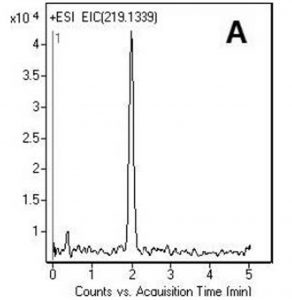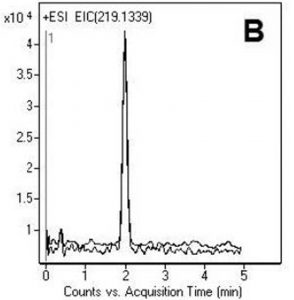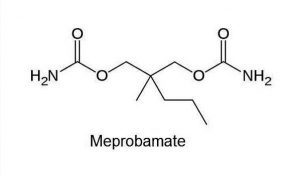Rapid & Simple Analysis of Meprobamate. One Step Sample Preparation with Plasma or Urine
Several methods have been reported in the literature for the quantification of Meprobamate in biological samples (plasma, urine, hair etc) for patient monitoring and other tests. Most of these methods present the drawbacks of long analysis time and complex sample pre-treatment (Derivatization, Solid or Liquid Phase Extraction).
The analytical strategy presented in this application note is rapid and simple and can be used for quantification in urine or plasma samples. A simple one-step protein precipitation with Acetonitrile is all that is required. When spiked urine samples were analyzed, no significant matrix effect was observed. Also there was no interference peak in blank urine samples (data not shown).
The [13C-2H3] – Meprobamate is recommended to be used as an internal standard and when a lower detection limit is required for the analysis, the use of LC-MS/MS is suggested.



Peaks:
A: Standard
B: 1st and 10th injection overlaid
Method Conditions
Column: Cogent Bidentate C18™, 4µm, 100Å
Catalog No.: 40018-05P-2
Dimensions: 2.1 x 50mm
Mobile Phase:
—A: DI Water + 0.1% Formic Acid
—B: Acetonitrile + 0.1% Formic Acid
Temperature: 30°C
Flow rate: 0.4mL / minute
Detection: ESI — POS – Agilent 6210 MSD TOF Mass Spectrometer
Injection vol.: 1μL
Sample Preparation: Meprobamate 219.1339 m/z (M+H)+ (RT = 1.996 min)
Note: Meprobamate is a carbamate compound used as a drug since the 1950’s. Still widely prescribed as a sedative and more recently in the treatment of alcoholic withdrawal syndrome, it can be toxic which under some circumstances can lead to death. It is very often involved in accidental or suicidal overdoses. For all these reasons identification and quantification of this drug is very important in toxicology for patient monitoring and clinical studies.
Attachment
No 118 Meprobamate Analysis by LCMS pdf 0.2 Mb Download File


